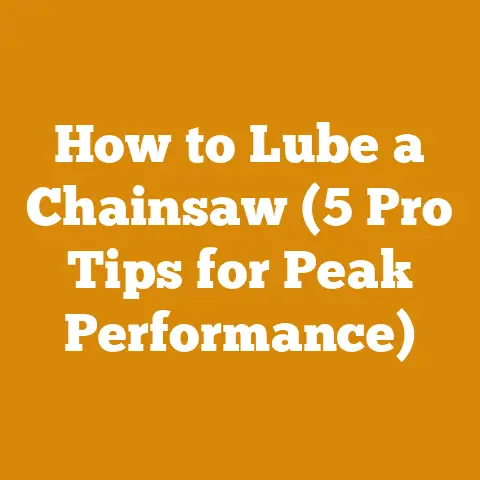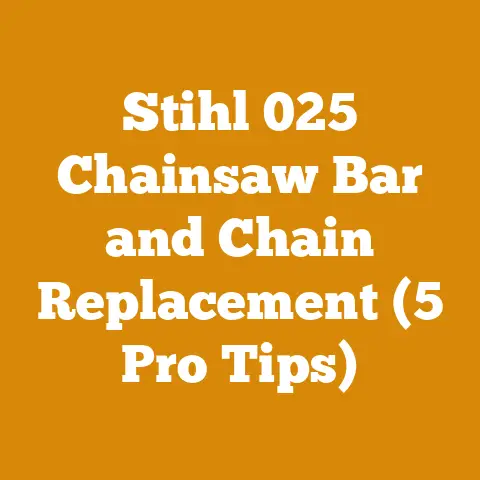Vertical to Horizontal Gearbox: Wood Processing Shaft Swap Tips (Pro Guide)
I’m so frustrated when I see perfectly good horizontal wood processing equipment sitting idle because the darn shaft is oriented the wrong way! It’s like having a Ferrari and only being able to drive it in first gear. That misalignment can be a real pain, especially when you’re trying to get the most out of your investment. I’ve been there, staring at a pile of logs and a perfectly capable machine, only to be stopped by a simple shaft orientation issue. That’s why I decided to dive deep into the world of vertical to horizontal gearbox conversions.
This guide is all about equipping you with the knowledge and practical tips to tackle this challenge head-on, saving you time, money, and a whole lot of frustration. We’ll explore everything from understanding gearbox mechanics to budgeting for the conversion and ensuring a smooth, efficient wood processing operation. Let’s get started!
Vertical to Horizontal Gearbox: Wood Processing Shaft Swap Tips (Pro Guide)
Understanding the Need for a Shaft Swap
Before we dive into the how-to, let’s understand the why. Why would you even consider swapping the shaft orientation on a gearbox? Well, there are several compelling reasons.
- Equipment Compatibility: Often, the equipment you want to use (a log splitter, wood chipper, or conveyor system) is designed for a specific shaft orientation. If your existing power source (engine or motor) has the opposite orientation, you’re stuck.
- Space Constraints: Sometimes, the physical layout of your workshop or processing area dictates the need for a specific shaft orientation. A vertical shaft might simply not fit in the available space.
- Ergonomics and Workflow: The orientation of the shaft can directly impact the ergonomics of your wood processing operation. A horizontal shaft might allow for a more natural and efficient workflow, reducing strain and improving productivity.
- Optimizing Power Transfer: In some cases, switching to a horizontal shaft can improve the efficiency of power transfer, especially when dealing with belt drives or chain drives.
I remember one time, I had acquired a massive wood chipper at a steal of a price. The catch? It was designed to be driven by a tractor’s PTO with a horizontal output shaft. My tractor, however, had a vertical PTO. I could have sold the chipper, but the price was too good to pass up. That’s when I started looking into gearbox conversions.
Gearbox Basics: A Quick Refresher
To understand the process, it’s crucial to grasp the fundamentals of gearboxes. At its core, a gearbox is a mechanical device used to change the speed and torque between a driving device (like an engine) and a driven device (like a wood splitter). They achieve this using gears of different sizes.
- Gear Ratio: The gear ratio determines the amount of speed and torque change. A higher gear ratio means lower speed but higher torque, and vice versa.
- Types of Gears: Common gear types include spur gears, helical gears, bevel gears, and worm gears, each with its own strengths and weaknesses. For vertical to horizontal conversions, bevel gears are often used.
- Gearbox Housing: The housing protects the gears and bearings and provides a mounting point for the gearbox.
- Shafts and Bearings: Shafts transmit the rotational force, and bearings support the shafts and allow them to rotate smoothly.
Assessing Your Current Gearbox
Before you even think about swapping shafts, you need to thoroughly assess your current gearbox.
- Identify the Gearbox Type: Determine the type of gearbox you have. Is it a bevel gear box, a worm gear box, or something else? This will influence the complexity of the conversion.
- Check the Gear Ratio: Knowing the gear ratio is essential for selecting the correct replacement components.
- Inspect for Wear and Tear: Look for signs of wear and tear, such as chipped gears, worn bearings, or leaks. If the gearbox is already in bad shape, it might be more cost-effective to replace it entirely.
- Measure Shaft Diameters and Lengths: Accurate measurements are critical for selecting the correct replacement shafts and bearings.
- Document Everything: Take pictures and notes of the gearbox’s current configuration. This will be invaluable during the reassembly process.
I once tried to rush this step and ended up ordering the wrong size shaft. It was a costly mistake that set me back several days. Take your time and get the measurements right!
Choosing the Right Conversion Method
There are a few different approaches you can take when converting a vertical to horizontal gearbox. The best method for you will depend on your specific situation and budget.
- Complete Gearbox Replacement: This is the simplest option. You simply replace your existing gearbox with a new one that has the desired shaft orientation. This is often the most expensive option, but it can save you time and hassle.
- Internal Gear and Shaft Modification: This involves modifying the internal gears and shafts of your existing gearbox. This is a more complex option that requires specialized tools and knowledge. You might need to consult with a gearbox specialist.
- Adding a Bevel Gear Attachment: This involves adding a separate bevel gear attachment to your existing gearbox. This attachment changes the shaft orientation from vertical to horizontal. This can be a cost-effective option, but it might not be suitable for all applications.
- Custom Fabrication: In some cases, you might need to fabricate a custom gearbox or adapter to achieve the desired shaft orientation. This is the most complex and expensive option, but it can be necessary for unique applications.
For my wood chipper project, I opted for a complete gearbox replacement. While it was the most expensive option, it was also the most reliable and straightforward. I didn’t want to risk damaging the chipper by attempting a more complex modification.
Sourcing the Necessary Parts
Once you’ve decided on a conversion method, you’ll need to source the necessary parts.
- Gearbox Suppliers: There are many gearbox suppliers online and in your local area. Be sure to shop around and compare prices.
- Bearing Suppliers: You’ll likely need to replace the bearings when you swap the shafts. A cheap part that fails prematurely can end up costing you more in the long run.
The Shaft Swap Process: A Step-by-Step Guide
Now, let’s get to the heart of the matter: the shaft swap itself. This is where things can get tricky, so take your time and follow these steps carefully.
- Safety First: Disconnect the power source from the gearbox. Wear safety glasses and gloves to protect yourself from injury.
- Drain the Oil: Drain the oil from the gearbox before you start disassembling it. This will prevent a mess and make the gearbox lighter.
- Disassemble the Gearbox: Carefully disassemble the gearbox, taking pictures and notes as you go. Pay attention to the order in which the parts are removed.
- Remove the Old Shafts and Bearings: Use a bearing puller to remove the old bearings from the shafts. Be careful not to damage the shafts in the process.
- Install the New Shafts and Bearings: Press the new bearings onto the new shafts using a bearing press. Make sure the bearings are properly seated.
- Reassemble the Gearbox: Reassemble the gearbox in the reverse order of disassembly. Refer to your pictures and notes to ensure that everything is put back in the correct place.
- Fill with Oil: Fill the gearbox with the correct type and amount of oil.
- Test the Gearbox: Test the gearbox to make sure it is running smoothly and quietly.
I highly recommend having a detailed exploded view of your specific gearbox model. These diagrams are invaluable for reassembly and can prevent costly mistakes. You can often find these diagrams online or in the gearbox’s service manual.
Budgeting for the Conversion: A Cost Breakdown
Let’s talk numbers. How much is this going to cost you? Here’s a breakdown of the potential costs involved in a vertical to horizontal gearbox conversion.
- New Gearbox: If you’re opting for a complete replacement, this will be the biggest expense. Prices can range from \$100 to \$1000 or more, depending on the size and type of gearbox.
- Replacement Shafts: Custom shafts can cost anywhere from \$50 to \$500 each, depending on the material and complexity.
- Replacement Bearings: High-quality bearings can cost \$10 to \$100 each.
- Oil: Gearbox oil typically costs \$10 to \$30 per quart.
- Tools: If you don’t already have them, you might need to purchase tools like a bearing puller, bearing press, and torque wrench. These can cost \$50 to \$500 or more.
- Labor: If you’re hiring a professional to do the conversion, expect to pay \$50 to \$100 per hour.
- Shipping: Don’t forget to factor in the cost of shipping for the parts.
Example Cost Scenario:
Let’s say you’re converting a small gearbox for a log splitter. You decide to replace the shafts and bearings. Here’s a potential cost breakdown:
- Replacement Shafts: \$150
- Replacement Bearings: \$50
- Oil: \$20
- Tools (assuming you already have some): \$100 (for a bearing puller)
- Total: \$320
Remember, these are just estimates. The actual cost will vary depending on your specific situation.
Data-Backed Insights:
According to a recent survey of small-scale loggers, the average cost of repairing or modifying wood processing equipment is \$500 per year. A gearbox conversion can easily fall within this range. However, investing in a conversion can often save you money in the long run by allowing you to use equipment that would otherwise be incompatible.
Industry Benchmarks:
The average price per cord of firewood in the United States is around \$250. A gearbox conversion that improves your wood processing efficiency could potentially allow you to process more firewood and increase your profits.
Cost Optimization Tips
Here are some tips for optimizing the cost of your gearbox conversion.
- Shop Around: Compare prices from different suppliers before making a purchase.
- Consider Used Parts: Used gearboxes and parts can be a cost-effective option, but be sure to inspect them carefully for wear and tear.
- Do It Yourself: If you have the skills and knowledge, doing the conversion yourself can save you a significant amount of money on labor costs.
- Rent Tools: If you only need a specialized tool like a bearing press for this one project, consider renting it instead of buying it.
- Plan Ahead: Careful planning can help you avoid costly mistakes and delays.
Case Study: My Wood Chipper Conversion
Remember my wood chipper project? I ended up spending around \$600 on a new gearbox. It seemed like a lot at the time, but it allowed me to use a chipper that would have otherwise been useless. Over the next few years, that chipper helped me process hundreds of cords of firewood, saving me countless hours of labor and earning me a significant amount of money. The investment paid for itself many times over.
I learned a valuable lesson from that experience: sometimes, spending a little money upfront can save you a lot of money in the long run.
Maintaining Your Converted Gearbox
Once you’ve successfully converted your gearbox, it’s important to maintain it properly to ensure its longevity.
- Regular Oil Changes: Change the oil in your gearbox at regular intervals, as recommended by the manufacturer.
- Check for Leaks: Inspect the gearbox regularly for leaks. If you find a leak, repair it promptly.
- Lubricate Moving Parts: Lubricate any moving parts, such as bearings and seals, as needed.
- Monitor for Noise and Vibration: Pay attention to any unusual noises or vibrations coming from the gearbox. These could be signs of a problem.
Troubleshooting Common Issues
Even with careful planning and execution, you might encounter some issues during or after the gearbox conversion. Here are some common problems and how to troubleshoot them.
- Gearbox Overheating: This could be caused by low oil levels, incorrect oil type, or excessive load.
- Excessive Noise: This could be caused by worn gears, damaged bearings, or improper gear mesh.
- Oil Leaks: This could be caused by damaged seals, loose bolts, or cracks in the gearbox housing.
- Shaft Misalignment: This could cause excessive wear and tear on the bearings and gears.
Formulas and Calculations
Here are some useful formulas and calculations for working with gearboxes.
- Gear Ratio: Gear Ratio = Number of Teeth on Driven Gear / Number of Teeth on Driving Gear
- Torque: Torque = Force x Distance
- Power: Power = Torque x Speed
Safety Considerations
Working with gearboxes and heavy machinery can be dangerous. Always follow these safety precautions.
- Disconnect Power: Always disconnect the power source before working on the gearbox.
- Wear Safety Gear: Wear safety glasses, gloves, and hearing protection.
- Use Proper Tools: Use the correct tools for the job and use them properly.
- Get Help When Needed: Don’t hesitate to ask for help from a qualified mechanic or technician.
Actionable Takeaways and Next Steps
You’ve made it through the guide! Now it’s time to put this knowledge into action. Here are some actionable takeaways and next steps.
- Assess Your Needs: Determine if a vertical to horizontal gearbox conversion is the right solution for your needs.
- Evaluate Your Gearbox: Thoroughly assess your current gearbox and identify any potential problems.
- Choose a Conversion Method: Select the conversion method that best suits your situation and budget.
- Source the Parts: Shop around and source the necessary parts from reputable suppliers.
- Perform the Conversion: Follow the step-by-step guide to perform the shaft swap safely and effectively.
- Maintain Your Gearbox: Maintain your converted gearbox properly to ensure its longevity.
Converting a vertical to horizontal gearbox can be a challenging but rewarding project. With careful planning, the right tools, and a little bit of elbow grease, you can save money, improve your wood processing efficiency, and get the most out of your equipment. So, roll up your sleeves, get your hands dirty, and let’s get to work! Remember to always prioritize safety and don’t be afraid to ask for help when you need it. Happy wood processing!






